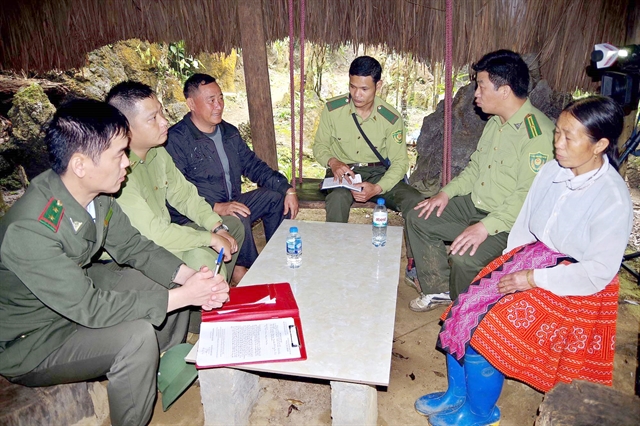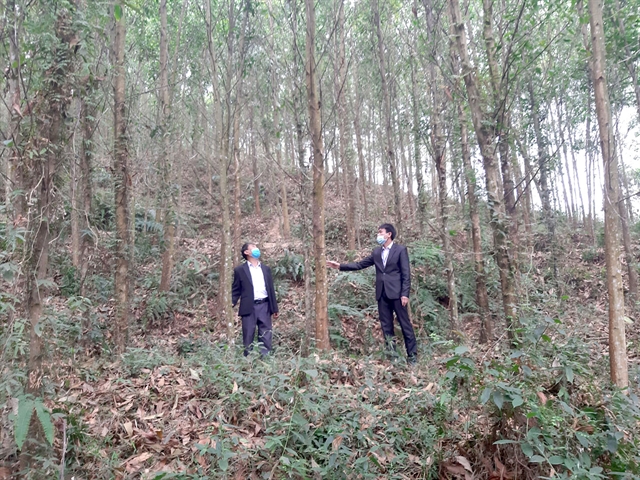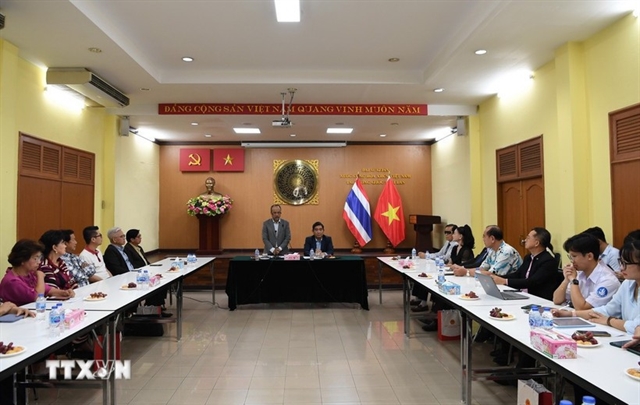 Features
Features

The local ethnic Mông in Hang Kia and Pà Cò Communes have made substantial contributions to protecting the environment and preserving the natural surroundings, maintaining resources associated with the development of sustainable eco-tourism.

|
| SUPPORT & DIRECTION: Khà A Lứ (third left) and his wife (far right) speak with officials from the Hang Kia - Pà Cò Natural Reserve about the implementation of eco-tourism development plans. VNA/VNS Photo Thanh Hải |
On a trail leading to the top of Rồng (Dragon) Mountain, the highest peak in the northern mountainous province of Hòa Bình, lies the beautiful Hang Kia - Pà Cò Nature Reserve, straddling the two communes of Hang Kia and Pà Cò.
Along with picture-perfect landscapes, the most impressive thing about the location is that you may struggle to find any signs of human impact on the natural surroundings, despite it welcoming thousands of visitors each year.
Environmental pollution and forest devastation, which are common downsides of tourism development, especially in ethnic minority areas, have been fiercely tackled in the nature reserve.
Rubbish and plastics bags are never seen along roads or in local markets or homestays.

|
| FIELD TRIP: Khà A Lứ and his wife accompanying officials from the nature reserve’s Management Board to check on primitive forests near his home. VNA/VNS Photo Thanh Hải |

|
| FERTILE GROUND: Forest preservation is one of the main targets of eco-tourism development in the northern mountainous province of Hòa Bình. Photobaohoabinh.com.vn |
The local ethnic Mông have made substantial contributions to protecting the environment and preserving the natural surroundings, actively participating in strengthening the management and protection of forests and maintaining resources associated with the development of sustainable eco-tourism.
This is a new and progressive tourism model and helps attract tourists, creating opportunities for better incomes while boosting environmental protection.
Khà A Lứ, 54, a Mông farmer in Hang Kia Commune, has been active in a tourism business that regards forest preservation as a major target of sustainable development.
Lứ’s family was among the first households in the commune to be assigned by the Management Board of the Nature Reserve to manage and protect hundreds of hectares of primitive forest behind their house.
As soon as the land was allocated to him, about four years ago, he considered it "family property” and so did everything to protect it, he said.
“The forest had become seriously degraded by a lot of local people who considered it some kind of natural ‘gift’ they could use as they please, but now we protect it,” said Lứ.
To help others understand the benefits of forest protection, he said he first went door-to-door to each neighbouring household to meet every person in the village and tell them about the dangers that come from illegal logging and serious deforestation.
“My family and I also began trying to recover damaged forests by nurturing and replanting various trees, as well as flowers and precious plants,” he added.
After much hard work and with support from officials at the Management Board of the Hang Kia - Pà Cò Nature Reserve, Lứ and his wife decided to participate in a plan adopted by local authorities on eco-tourism development, integrating natural preservation with tourism development as the key target.
By adding a variety of new trees and flowers such as orchids and ancient rhododendrons as well as palm trees, the couple successfully turned their primitive forest area into an eco-tourism destination with homestays and trekking routes.
They also introduced more tourism services, including cuisine that promoted the identity of the Mông people, such as pork and chicken delicacies and cakes made of sticky rice.
Beyond focusing on encouraging his relatives and neighbours to protect the forest, Lứ and his wife, Vàng Y Mại, also visited nearby villages such as Pà Cò Con, Pà Háng Con, and Pà Háng Lớn to convince people not to chop down trees but instead protect them and become involved in the eco-tourism business.
He also explained to them that eco-tourism holds vast potential for local socio-economic development and used his own experience as an example of doing business by preserving and protecting the local forest area.
His efforts and contributions to sustainable socio-economic development, particularly in forest preservation, have been recognised by local people and authorities.
A respected elder in Pà Cò Con Village, Sùng A Sa, appreciated the work Lứ and his wife have done.
He emphasised that he and his villagers understand Lứ’s thinking and are trying to follow in his footsteps.
“We should learn from Lứ and mirror the things he has done,” Sa said.
“Our children and grandchildren need to learn not to abuse the local forests. We must tell them that preserving the surrounding area provides a future for everyone.”
Appealing attractions
Located in Việt Nam’s northwest mountains at an altitude of 1,200-1,500 metres above sea level, Hang Kia and Pà Cò Communes are covered by large swathes of forest often blanketed in cloud.
It’s not only a great hideaway from the summer heat but also worth a visit during autumn.
Leaving the centre of Mai Châu District and travelling some 30km over a mountain 1,200m above sea level, visitors will reach Pà Cò Commune and after about 10km more find themselves in Hang Kia.
Looking down when the skies are clear, they can admire the green of the mountains and the forests dotted with the homes of the Mông, winding roads with sharp bends, tea hills, stone fences, and yellow canola flowers.
Inside the villages are Mông women embroidering their clothes as their children play.
Thin streams of smoke snaking up from household kitchens help people leave their concerns behind and enjoy a sense of tranquillity.
Hang Kia and Pà Cò are also home to many small valleys, with the terrain being primarily steep hills and mountains.
Almost all of the two communes’ populations are Mông, who have also maintained traditional crafts such as weaving, indigo dyeing, wax painting, and iron forging.
They used to be caught up in the drug trade but life is now peaceful once more, with facilities such as schools, medical stations, and telecommunications networks improving lives.
Many households have begun to develop different forms of eco-tourism and community tourism.
“For many years, the local government wondered how best to increase the incomes of people in Hang Kia and Pà Cò,” said Đặng Mai Sơn, chairman of the Mai Châu District People’s Committee.
“The development of eco-tourism and community tourism has been identified as a means for people to develop the local economy while preserving and promoting their unique cultural values.
“Tourists and domestic and international travel agencies now know about Hang Kia and Pà Cò, but there are still not enough households involved in community tourism." VNS




